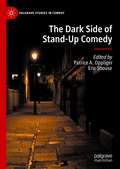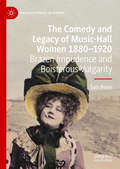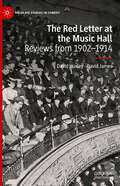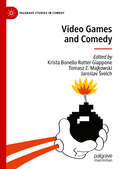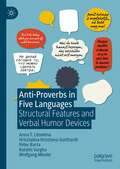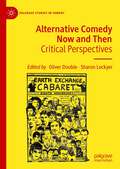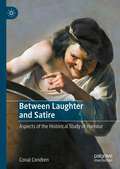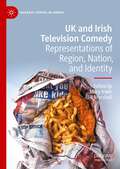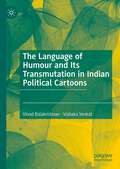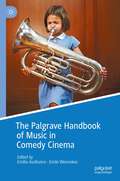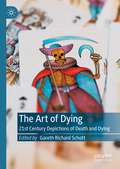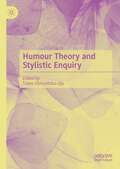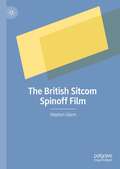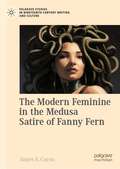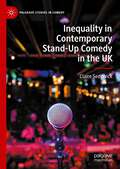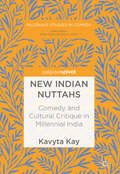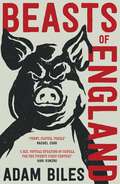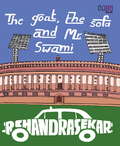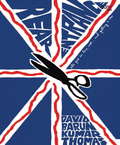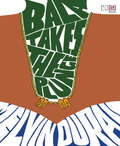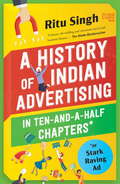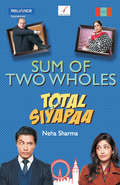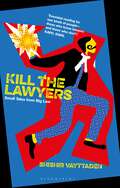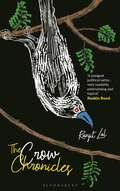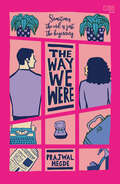- Table View
- List View
The Dark Side of Stand-Up Comedy (Palgrave Studies in Comedy)
by Patrice A. Oppliger Eric ShouseThis book focuses on the “dark side” of stand-up comedy, initially inspired by speculations surrounding the death of comedian Robin Williams. Contributors, those who study humor as well as those who perform comedy, join together to contemplate the paradoxical relationship between tragedy and comedy and expose over-generalizations about comic performers’ troubled childhoods, addictions, and mental illnesses. The book is divided into two sections. First, scholars from a variety of disciplines explore comedians’ onstage performances, their offstage lives, and the relationship between the two. The second half of the book focuses on amateur and lesser-known professional comedians who reveal the struggles they face as they attempt to hone successful comedy acts and likable comic personae. The goal of this collection is to move beyond the hackneyed stereotype of the sad clown in order to reveal how stand-up comedy can transform both personal and collective tragedies by providing catharsis through humor.
The Comedy and Legacy of Music-Hall Women 1880-1920: Brazen Impudence and Boisterous Vulgarity (Palgrave Studies in Comedy)
by Sam BealeThis book explores the comedy and legacy of women working as performers on the music-hall stage from 1880–1920, and examines the significance of their previously overlooked contributions to British comic traditions. Focusing on the under-researched female ‘serio-comic’, the study includes six micro-histories detailing the acts of Ada Lundberg, Bessie Bellwood, Maidie Scott, Vesta Victoria, Marie Lloyd and Nellie Wallace. Uniquely for women in the late-nineteenth and early-twentieth centuries, these pioneering performers had public voices. The extent to which their comedy challenged Victorian and Edwardian perceptions of women is revealed through explorations of how they connected with popular audiences while also avoiding censorship. Their use of techniques such as comic irony and stereotyping, self-deprecation, and comic innuendo are considered alongside the work of contemporary stand-up comedians and performance artists including Bridget Christie, Bryony Kimmings, Sara Pascoe, Shazia Mirza and Sarah Silverman.
The Red Letter at the Music Hall: Reviews from 1902–1914 (Palgrave Studies in Comedy)
by David Huxley David JamesThis book reprints and analyses reviews of music hall acts from the family magazine The Red Letter, which was published by the Scottish based firm D C Thomson from 1899 to 1987. The articles under review range in date from 1902 to 1914, covering theatres all over Britain and acts from around the world. The reviews are uniquely detailed and shed light not only on the early acts of comics who would later go on to achieve wider fame, such as Will Hay and Robb Wilton, but also reveal the acts of long forgotten performers. These so-called ‘wines and spirits’ acts—acts that would never top the bill but who nevertheless toured the halls, sometimes for years on end, such as female impersonator Albert Letine, comedy magician Chris van Bern and female stand up Anna Dorothy amongst many others—deserve to be remembered every bit as much as the top of the bill acts. The articles are arranged in sections, covering race, gender, character comedy, physical comedy, male comedy and specialty or ‘spesh’ acts. The reviews reveal not only the contents of the acts but also the audience reactions to those acts and prevailing contemporary Edwardian attitudes. The articles are accompanied by their original illustrations, some of which are unique and, like the articles themselves, unseen for over a century.
Video Games and Comedy (Palgrave Studies in Comedy)
by Krista Bonello Rutter Giappone Tomasz Z. Majkowski Jaroslav ŠvelchVideo Games and Comedy is the first edited volume to explore the intersections between comedy and video games. This pioneering book collects chapters from a diverse group of scholars, covering a wide range of approaches and examining the relationship between video games, humour, and comedy from many different angles. The first section of the book includes chapters that engage with theories of comedy and humour, adapting them to the specifics of the video game medium. The second section explores humour in the contexts, cultures, and communities that give rise to and spring up around video games, focusing on phenomena such as in-jokes, player self-reflexivity, and player/fan creativity. The third section offers case studies of individual games or game series, exploring the use of irony as well as sexual and racial humour in video games.
Anti-Proverbs in Five Languages: Structural Features and Verbal Humor Devices
by Wolfgang Mieder Anna T. Litovkina Hrisztalina Hrisztova-Gotthardt Péter Barta Katalin VarghaThis book is the first comparative study of English, German, French, Russian and Hungarian anti-proverbs based on well-known proverbs. Proverbs are by no means fossilized texts but are adaptable to different times and changed values. While anti-proverbs can be considered as variants of older proverbs, they can also become new proverbs reflecting a more modern worldview. Anti-proverbs are therefore a lingo-cultural phenomenon that deserves the attention of cultural and literary historians, folklorists, linguists, and general readers interested in language and wordplay.
Alternative Comedy Now and Then: Critical Perspectives (Palgrave Studies in Comedy)
by Oliver Double Sharon LockyerAlternative Comedy Now and Then: Critical Perspectives is the first academic collection focusing on the history and legacy of the alternative comedy movement in Britain that began in 1979 and continues to influence contemporary stand-up comedy. The collection examines the contexts, performances and reception of alternative comedy in order to provide a holistic approach to examining the socio-political impact and significance of alternative comedy from its historical roots through to present day performances. As alternative comedy celebrated its 40th anniversary in 2019, critically reflecting on its impact and significance is a timely endeavour. The book adopts a distinctive interdisciplinary approach, synthesizing theory, concepts and methodologies from comedy studies, theatre and performance, communication and media studies, sociology, political sciences and anthropology. This approach is taken in order to fully understand and examine the dynamics and nuances of the alternative comedy movement which would not be possible with a single-discipline approach.
Between Laughter and Satire: Aspects of the Historical Study of Humour
by Conal CondrenThis book explores closely related aspects of the historical study of humour. It challenges much that has been taken for granted in a field of study for which history has been marginal. It disputes the conventional genealogical view that humour theory dates from antiquity and outlines an alternative conceptual history. It critically examines the nostrum that humour is universal. It then explores the methodological difficulties in treating both verbal and non-verbal humour historically, dealing with contextualisation, intentionality, translation and reception. It explores the variable relationships between satire and definition and concludes with a detailed case study from recent history: the iconic Yes Minister and Yes, Prime Minister television comedies. These are commonly seen as realistic, but better understood as presenting popularised theories for satiric and propagandistic effect. Only in their treatment of language can we assess a putative political realism. The satires are often highly perceptive but largely dependent on misleading and inadequate theories of political discourse.Conal Condren is an Emeritus Scientia Professor at UNSW, a member of two Cambridge Colleges and a fellow both of the Australian Academy of the Humanities and The Social Sciences in Australia. He has published widely and principally in early modern intellectual history. Among his books are The Status and Appraisal of Classic Texts; Argument and Authority in Early Modern England; Political Vocabularies: Word Change and the Nature of Politics.
UK and Irish Television Comedy: Representations of Region, Nation, and Identity (Palgrave Studies in Comedy)
by Mary Irwin Jill MarshallThis book looks at television comedy, drawn from across the UK and Ireland, and ranging chronologically from the 1980s to the 2020s. It explores depictions of distinctive geographical, historical and cultural communities presented from the insiders’ perspective, simultaneously interrogating the particularity of the lived experience of time, and place, embedded within the wide variety of depictions of contrasting lives, experiences and sensibilities, which the collected individual chapters offer. Comedies considered include Victoria Wood’s work on ‘the north’, Ireland’s Father Ted and Derry Girls, Michaela Coel’s east London set Chewing Gum, and Wales’ Gavin and Stacey. There are chapters on Scottish sketch and animation comedy, and on series set in the Midlands, the North East, the South West and London’s home counties. The book offers thoughtful reflection on funny and engaging representations of the diverse, fragmented complexity of UK and Irish identity explored through the intersections of class, ethnicity and gender.
The Language of Humour and Its Transmutation in Indian Political Cartoons
by Vinod Balakrishnan Vishaka VenkatThis book develops a model to examine the language of humour, which is multimodal and accounts for the possibility of transmutation of humour as it is performed through editorial cartoons. By transmutation is meant the transition in the language of humour when it crosses its own boundaries to provoke unprecedented reactions resulting in offensiveness, disappointment or hurt sentiment. The transmutability about the language of humour points to its inherently diabolical nature which manifests in the performance of controversial cartoons. The model is built by borrowing theoretical cues from Roman Jakobson, Roland Barthes, George Lakoff and Mark Johnson. The integrated model, then, is developed to examine the cartoons which were recommended for deletion by the Thorat Committee, following a cartoon controversy in India. Through the cartoon analysis, the model discerns the significance of context and temporality in determining the impact of humour. It also examines how the ethics of humour; the blurred lines of political correctness and incorrectness are dictated by the political atmosphere and the power dynamics.
The Palgrave Handbook of Music in Comedy Cinema
by Emilio Audissino Emile WennekesThis handbook tackles the understudied relationship between music and comedy cinema by analysing the nature, perception, and function of music from fresh perspectives. Its approach is not only multidisciplinary, but also interdisciplinary in its close examination of how music and other cinematic devices interact in the creation of comedy. The volume addresses gender representation, national identities, stylistic strategies, and employs inputs from cultural studies, musicology, music theory, psychology, cognitivism, semiotics, formal and stylistic film analysis, and psychoanalysis. It is organised in four sections: general introductions, theoretical investigations, music and comedy within national cinemas, and exemplary case studies of films or authors.
The Art of Dying: 21st Century Depictions of Death and Dying
by Gareth Richard SchottThe Art of Dying: 21st Century Depictions of Death and Dying examines how contemporary media platforms are used to produce creative accounts, responses and reflections on the course of dying, death and grief. Outside the public performance of grief at funerals, grief can strike in anticipation of a loss, or it can endure, continuing to interject itself and interrupt a permanently changed life. This book examines the particular affordances possessed by various contemporary creative forms and platforms that capture and illuminate different aspects of the phenomenology of dying and grief. It explores the subversive and unguarded nature of stand-up comedy, the temporal and spatial inventiveness of graphic novels, the creative constructions of documentary filmmaking, the narrative voice of young adult literature, the realism of documentary theatre, alongside more ubiquitous media such as social media, television and games. This book is testament to the power of creative expression to elicit vicarious grief and sharpen our awareness of death.
Humour Theory and Stylistic Enquiry
by Taiwo Oloruntoba-OjuThis edited book brings together scholarly chapters on linguistic aspects of humour in literary and non-literary domains and contexts in different parts of the world. Previous scholarly engagements and theoretical postulations on humour and the comic provide veritable resources for reexamining the relationship between linguistic elements and comic sensations on the one hand, and the validity of interpretive humour stylistics on the other hand. Renowned Stylistics scholars, such as Michael Toolan, who writes the volume’s foreword against the backdrop of nearly four decades of scholarly engagement with stylistics, and Katie Wales, who in this volume engages with Charles Dickens, one of the most eminent satirists in English literature, as well as many other European and African authors who have worked ceaselessly in the area of humour and language, weigh in on the topic of language and humour in this volume. Together, they provide a variety of interesting perspectives on the topic, deploying different textual sources from different media and from different regions of the world. Part of the book’s offering includes integrative stylistic approaches to humour in African, European and American written texts, examinations of social media and political humour in Nigeria, Cameroon and Zimbabwe, pragmatics and humorous stance-taking, incongruity as comedy in works of fiction, and a unified levels of linguistic analysis approach to the investigation of humour. This book will be of interest to academics and students of Linguistics, Stylistics, Communications and Media Studies, and Humour Studies. Taiwo Oloruntoba-Oju is a Professor in the Department of English at the University of Ilorin in Nigeria
The British Sitcom Spinoff Film
by Stephen GlynnThis book constitutes the first full volume dedicated to an academic analysis of theatrically-released spinoff films derived from British radio and television sitcoms. Regularly maligned as the nadir of British film production and marginalised as a last resort for the financially-bereft industry during the 1970s, this study demonstrates that the sitcom spinoff film has instead been a persistent and important presence in British cinema from the 1940s to the present day, and includes (occasional) works with distinct artistic merit. Alongside an investigation of the economic imperative underpinning these productions, i.e. the exploitation of proven product with a ready-made audience, it is argued that, with a longevity stretching from Arthur Askey and his wartime Band Waggon (1940) to the crew of Kurupt FM and their recent People Just Do Nothing: Big in Japan (2021), the British sitcom spinoff can be interpreted as following a full generic ‘life cycle’. Starting with the ‘formative’ stage where works from Hi Gang! (1941) to I Only Arsked! (1958) establish the genre’s characteristics, the spinoff genre moves to its ‘classic’ stage where, secure for form and content, it enjoys considerable popular success with films like Till Death Us Do Part (1969), On the Buses (1971), The Likely Lads (1976) and Rising Damp (1980); the genre’s revival since the late-1990s reveals a more ‘parodic’ final stage, with films like The League of Gentlemen’s Apocalypse (2005) adopting a consciously self-reflective mode. It is also posited that the sitcom spinoff film is a viable source for social history, with the often-stereotypical re-presentations of characters and events an (often blatant) ideological metonym for the concerns of wider British society, notably in issues of class, race, gender and sexuality.
The Modern Feminine in the Medusa Satire of Fanny Fern (Palgrave Studies in Nineteenth-Century Writing and Culture)
by James E. CaronThe Modern Feminine in the Medusa Satire of Fanny Fern argues that Sara Parton and her literary alter ego, Fanny Fern, occupy a star-power position within the antebellum literary marketplace dominated by women authors of sentimental fiction, writers Nathaniel Hawthorne (in)famously called “the damn mob of scribbling women.” The Fanny Fern persona represents a nineteenth-century woman voicing the modern feminine within a laughter-provoking bourgeois carnival, a forerunner of Hélène Cixous’s laughing Medusa figure and her theory about écriture féminine. By advancing an innovative theory about an Anglo-American aesthetic, comic belles lettres, Caron explains the comic nuances of Parton’s persona, capable of both an amiable and a caustic satire. The book traces Parton’s burgeoning celebrity, analyzes her satires on cultural expectations of gendered behavior, and provides a close look at her variegated comic style. The book then makes two first-order conclusions: Parton not only offers a unique profile for antebellum women comic writers, but her Fanny Fern persona also anchors a potential genealogy of women comic writers and activists, down to the present day, who could fit Kate Clinton’s concept of fumerism, a feminist style of humor that fumes, that embraces the comic power of a Medusa satire.
Inequality in Contemporary Stand-Up Comedy in the UK (Palgrave Studies in Comedy)
by Claire SedgwickThis Pivot explores the cultural economy of comedy in the UK, looking specifically at the links between industry practices and structures and who produces comedy in the UK. The research is based on interviews with comedians in the East Midlands; significantly, this demographic has been historically under-researched in studies of precarity, where the East Midlands is typically overlooked in discussions of arts funding and access in favour of a more simplistic north/south divide narrative. Similarly, whilst there has been increased discussion of the precarity of the creative and cultural industries, as well as media articles on the difficulty of breaking into comedy as a member of a marginalised group, there has been relatively little academic research to support this. While Friedman’s work in particular has been helpful for understanding the link between comedy producers, class and taste making, there has been less attention paid to the sociologies of work within comedy. This book fillsthese gaps in research by exploring the experiences of comedians in the East Midlands, contributing to the rich body of scholarship on inequality in the cultural industries and promoting a better understanding of the impact of structural inequalities and precarity on access to the cultural industries.
New Indian Nuttahs: Comedy and Cultural Critique in Millennial India (Palgrave Studies in Comedy)
by Kavyta KayThis book takes a journey into the new and exciting created by a the wave of Indian comedians today, described affectionately here as the New Indian Nuttahs, and looks at what these tell us about identity, “Indianness”, censorship, feminism, diaspora and millennial India. It provides a unique analysis into the growing phenomenon of internet comedy and into a dimension of Indian popular culture which has long been dominated by the traditional film and television industries. Through a mixture of close textual readings of online comedy videos and interviews with content creators and consumers in India, this book provides a fresh perspective on comedy studies in its approach to a global South context from a sociocultural perspective. As a protean form of new media, this has opened up new avenues of articulation, identification and disidentification and as such, this book makes a further contribution to South Asian, communication, media & cultural studies.
Beasts of England
by Adam BilesFunny, clever, timely' RACHEL CUSK'A sly, topical updating of Orwell for the twenty-first century' HARI KUNZRUManor Farm has reinvented itself as the South of England’s premium petting zoo. Now, instead of a working farm, humans and beasts alike are invited (for a small fee) to come and stroke, fondle, and take rides on the farm’s inhabitants.But life is not a bed of roses for the animals, in spite of what their leaders may want them to believe. Elections are rigged, the community is beset by factions, and sacred mottos are being constantly updated. The Farm is descending into chaos. What’s more, a mysterious ‘illness’ has started ripping through the animals, killing them one by one …In Beasts of England, Adam Biles honours, updates and subverts George Orwell’s classic, all the while channelling the chaotic, fragmentary nature of populist politics in the Internet age into a savage farmyard satire.
The Goat, the Sofa & Mr Swami
by R ChandrashekharA politically weighted cricket match between Pakistan and India provides the setting for the hilarious farce, set in a delightful ‘Yes Minister’ format. The Pakistani Premier's sudden decision to invite himself to a cricket series to be played in India creates uncertainly, panic and bureaucratic gamesmanship in New Delhi. Seemingly above such mundane concerns, India's elderly Prime Minister, devoted to movies, scotch, and late mornings, adds to the confusion with random utterances and occasional temper tantrums. His official factotum, a bureaucrat named Swami, plays the confusion for all it is worth, attempting to advance his career and settle old scores. Old rivalries between the Foreign Service and the domestic bureaucrats flare up as the day of the Pakistani Premier's visit approaches. Matters get stalled as rival departments choose to hide behind arcane laws. Conscious of his place in history and of the damage a botched visit would cause, the Prime Minister stages his own protests. Swami is forced to chart a treacherous course between his political and bureaucratic masters. A parable rooted in the absurdities of modern India, this novel takes a light-hearted dig at the pretensions of people who matter.
Rear Entrance
by David Barun ThomasSix months in dreary and cold Brussels – and no headway with her handsome colleague Luc – has convinced systems analyst Seetha, brought up in ‘steamy’ Madras, that she must move on. The British Government’s immigration laws allow writers and artists to be granted a visa even if they have no job, so Seetha decides that she is a writer – and her first creative assignment is her visa application form. Harish, escaping the slums of India, has slogged hard in Belgium for the last fourteen years, and finally has saved enough to fulfil a lifelong dream: watch a cricket match at Lords in London. Amit seems to have everything – except his strict father’s approval, which he may win if he finds a way to launder the $2 million his father moved out of India ‘during the restrictive years of Nehruvian socialism’. To Ratnesh, who hates the Indian caste system, and as a Dalit, plans to seek asylum in the UK, all’s fair in love, war, and getting a visa. Even using the naïve Harish for his own ends. And across the desk from them all, holding their fate in his hands, is British visa officer Doug Evans… who himself does not know what is going to happen at the end of the two days in which these characters lives, dreams – and visa applications – cross paths.
Bala Takes the Plunge
by Melvin DuraiBala dreams of making Tamil films and directing his favourite actor Rajnikanth – a dream that leads him naturally to study engineering in college. This earns him his father's approval and the opportunity to export himself to America. As Director of Design at Flexit Inc., thinking up new ways to help Americans shed the excess weight around their middles and in their wallets, he is at least some kind of director. Bala loves America, and America it seems loves him even more. He has everything he needs to be happy: a green card, a satellite dish to watch cricket and a companion to share his home – albeit one with a very limited vocabulary. But he is now less than a year away from the big 30, and if he doesn't act fast he might have to settle for whichever bride his Amma chooses. So begins Bala's quest for romance as he meets both American and Indian women some who are too old, others too young, and yet others just too stuck up. Will he ever find someone just right for him – and good enough to inherit his mother's Corelle dishes?
Stark Raving Ad: A Giddy Guide to Indian Ads You Love (or Hate)
by Ritu SinghPresenting, for the first time ever, the whole truth about Indian advertising and nothing but the truth (with just a pinch of salt). For centuries, Indians have been asking all kinds of questions – about the meaning of life, our place in the cosmos, why we have so many gods, and other such vital things. In the last hundred-odd years, marketing and advertising has given us none of those answers. What it has given us, nonetheless, is life-altering stuff. It has attempted to make men Fair and Handsome. It has battled to make women 18 Again. And to both men and women it has given Tinder loving care. It has made us realize that we like pizza as much as the next Italian – as long as Dominos puts keema dopyaaza on it and tempts us with, ‘Hungry kya?’ It has made us re-evaluate our life choices and ask thought-provoking questions like ‘Kitna deti hai?’ of our cars and ‘Kya aap Close-Up karte hain?’ of our countrymen. In short, it has enriched our lives with quirky quips, unforgettable characters, inter-brand scuffles, clever insights, virtual lures and jaw-dropping controversies. In Stark Raving Ad, you’ll find unbusiness-like stories from Indian advertising through the ages – the hits, the misses, the also-rans and the banned. This is the non-classic book about advertising in India that no one asked for.'
Total Siyapaa
by Neha Sharma"Sum of Two Wholes TOTAL SIYAPAA" Aasha Singh, fiery and confident, can't wait to get her hands dirty with hard news, and uncover scandals and controversies. A Punjabi desi in London, from India. Aman Ali, smart-aleck and suave, a promising musician, has left the security of a career in finance to follow his passion in music.
Kill the Lawyers
by Shishir VayttadenSet around the guns for hire at a fictional Bombay law firm, Kill the Lawyers renders a hilarious account of Big Law-the industry term for large, full-service corporate law firms. It debuts Edamarra Edwin, an irreverent junior partner who frolics with the law while helping friends and clients through their direst straits. In nine droll stories, Edwin wiles out victory from the most hopeless situations with a little help from his spunky young associate and an old Bombay 'operator'. In their wandering timeline these stories chart the arc of Edwin's astonishing rise in life. Shishir Vayttaden's long experience as a corporate lawyer gives authenticity to this work of pure fiction, and his skill as a storyteller makes it both deeply engaging and immensely amusing.
The Crow Chronicles
by Ranjit LalThe corrupt, though democratically elected avian government of the Keoladeo NationalPark, Bharatpur is forcibly taken over by a monstrous white crow from Bombay and hiscrack force of commando 'crownies', by means of treachery, deceit and violence. A steel-taloneddictatorship is imposed on the park and all fundamental rights annulled. Butthis desperate hour produces unlikely heroes. There is Achaanak the shikra for one,Titiri, editor of Did He Do It?, Phutki the tailorbird and a host of other citizens, evenGhughuji, the great horned owl who is so given to preaching. Meanwhile, the evilleaders of the erstwhile government, notably Chakumar Billa the tomcat and Budhboothe bandicoot, plot their own return to power. What ensues is a bitter battle forsupremacy.
The Way We Were: A hilarious and swoon-worthy second-chance, workplace romance
by Prajwal Hegde"Bitter rivals.Reluctant colleagues. Tormented ex-lovers. Myra Rai is living her best life. At twenty-eight, she is a prominent journalist at the precipice of dreamy success and her dating life is the envy of the town. After all, jealous heads stir to probe her almost engagement to Ravi Rao, the gentleman heir to a roaring political legacy! Myra is well on her course. Until comes knocking the broad-shouldered, chiselled-face ghost from her past... Andrew Brown is a headstrong political activist, unexpectedly back in the city after a winning stint in the US. Set to take over as the executive editor of Morning Herald, he is determined to revisit his past and reconnect with that one feisty journalist at work who hates his guts, hates that he is back, and hates that he never called... Both Myra and Andrew have lost a lot over the years, including each other. But in the fierce race to best one another while pretending not to seethe in the hellfire of jealousy and suppressed passion, can they keep their barbs (and hands) to themselves? Right from the centre of a smouldering passion-fest, Prajwal Hegde tugs compellingly at the heartstrings and delivers a stormy rom-com that is all love (AND a whole lot of lust)! "
